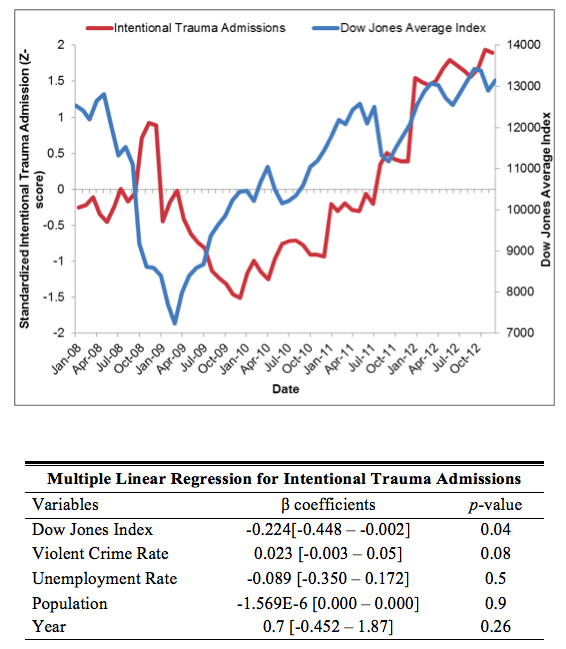B. Zangbar1, P. Rhee1, S. Mirghasemi1, N. Kulvatunyou1, A. Tang1, T. O’Keeffe1, D. Green1, R. Latifi1, R. S. Friese1, B. Joseph1 1University Of Arizona,Trauma Surgery,Tucson, AZ, USA
Introduction: Several factors have been suggested to explain the variation in intentional trauma admissions. However, the impact of changing economic conditions on trauma admissions remains unknown. The aim of this study was to determine the association between economic indicators and intentional trauma admission rate.
Methods: We performed a 5-year (2008-2012) retrospective analysis of state trauma database. Intentional injury was defined as self-inflicted injury or assault. Rate of admission of trauma patients with intentional injury was calculated per day. After smoothing the admission rates using centered moving average, data was adjusted for seasonal variation, state unemployment rate, state crime rate, and estimated state population. Dow Jones Industrial Average (DJI) was used as an indicator for economic changes in United States. Correlation and multivariate linear regression analysis was performed.
Results: A total of 142,738 trauma admissions were identified of which 21,540 were due to intentional trauma. DJI significantly correlated with intentional trauma admissions (p=0.004). After adjusting for unemployment rate, crime rate, state population, and time trend DJI was independently associated with intentional trauma admissions (β= -0.224, 95% CI= -0.448 – -0.02, p=0.04). For every 1000 unit decrease in DJI, intentional trauma admissions increased by 0.22 per month.
Conclusion: Variation in economic conditions independently impacts intentional trauma admissions independently. A nation wide evaluation may help in identifying additional social factors and the true nature of this association.
